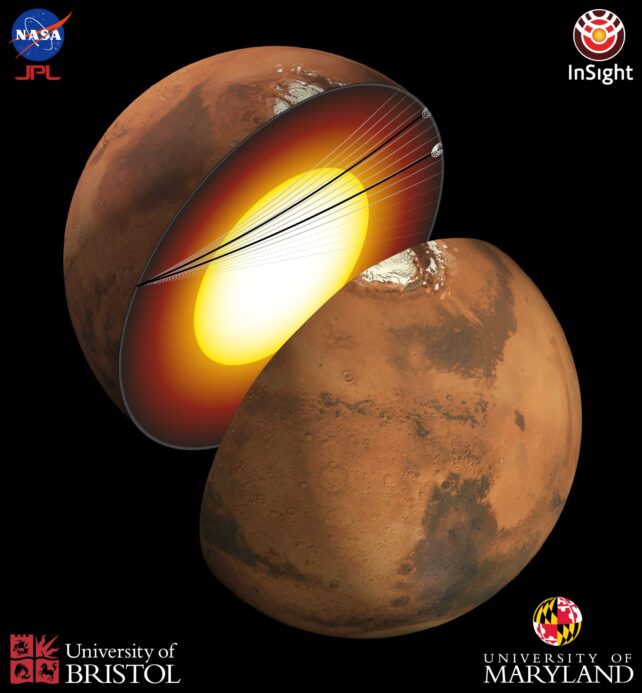Quakes rumbling through Mars have been detected rolling through its gooey core for the first time, giving scientists the tools they need to figure out what, exactly, Mars' heart is made of.
According to seismic data obtained using NASA's InSight lander, which monitored the red planet's innards for four years, Mars' center is a liquid iron alloy, with surprisingly large amounts of sulfur and oxygen mixed in.
It's information that can help scientists better understand Mars' history, and why it is different from Earth – one planet an arid, lifeless dustball, the other lush and teeming.
"In 1906, scientists first discovered the Earth's core by observing how seismic waves from earthquakes were affected by traveling through it," says geologist Vedran Lekic of the University of Maryland.
"More than a hundred years later, we're applying our knowledge of seismic waves to Mars. With InSight, we're finally discovering what's at the center of Mars and what makes Mars so similar yet distinct from Earth."
Quakes aren't just rumbles that imply internal activity in any given object. We now have the technology to use them as a sort of acoustic X-ray. They propagate outward from their point of origin, bouncing around inside a planet or moon or star before stilling to quietness. But the way they travel through, and reflect off, certain materials allows scientists to generate maps of the interior compositions of these bodies.
During its relatively short time monitoring the interior of Mars, InSight detected hundreds of marsquakes, giving us detailed information about the Martian interior. From this, scientists were able to compile the first detailed map of the guts of Mars, and learn more about the state of Mars' interior activity. Spoiler: it's not nearly as dead inside as we thought.
The Martian core remained unprobed, but in 2021, InSight logged two tremendous events on the opposite side of the planet: a giant marsquake bigger than anything the lander had detected, and a meteorite impact that rattled Mars. Because these events were on the far side of the planet from InSight, the lander could analyze different waves – those that traveled around Mars, and those that traveled through it, giving us the first seismic waves that we know moved through the Martian core.

These waves reveal the density and compressibility of the different materials they travel through, allowing a team led by planetary scientist Jessica Irving of Bristol University in the UK to break down what the Martian core is made of.
And here's where it's interesting. As opposed to Earth's core, which seems to be a liquid outer core, a solid inner core, and then an even denser innermost inner core, Mars' core seems to be squishy liquid all the way through. And Mars has a really high proportion of lighter elements mixed in through the inner core. Around a fifth of its weight is made up by these elements, predominantly sulfur, with smaller amounts of oxygen, carbon, and hydrogen.
This means that the core is less dense and more compressible than Earth's core, which could help scientists better understand the differences between the two planets.
We've long known that Mars doesn't have a global magnetic field. On Earth, the magnetic field helps keep the atmosphere and water from leaking into space. Known as the geodynamo, this is produced in Earth's core. Heat moves from the inner core to the outer core, which generates circulating currents that twist into patterns under the influence of the planet's rotation. This creates and maintains the magnetic field.
Previous research in which scientists simulated the Martian core suggested that the presence of lighter elements in Mars' core could have played a significant role in killing its dynamo and magnetic field. Now we have detailed information on what's actually in there so that scientists can reconstruct the history of Mars more accurately.
"It's like a puzzle in some ways," Lekic says. "For example, there are small traces of hydrogen in Mars' core. That means that there had to be certain conditions that allowed the hydrogen to be there, and we have to understand those conditions in order to understand how Mars evolved into the planet it is today."
This information could help hone our ability to search for life outside the Solar System. Mars and Earth are similar in many ways; working out how they differ, and why, can help scientists narrow down which alien worlds are most likely to host life. And it can teach us more about the different ways planets form, grow, and change over time, even from similar materials around the same star.
"This was a huge effort, involving state-of-the-art seismological techniques which have been honed on Earth, in conjunction with new results from mineral physicists and the insights from team members who simulate how planetary interiors change over time," Irving says.
"But the work paid off, and we now know much more about what's happening inside the Martian core."
The research has been published in the Proceedings of the National Academy of Science.
